IELTS Reading Question Types
The IELTS Reading Test
Both versions of IELTS, Academic and
General Training, measure reading skills in a test where you have to answer 4o questions in 60 minutes. There are differences in the number of and type of texts in the two versions: in
Academic IELTS, there are always three texts, in General Training usually five, with two short texts in each of the first two Sections, followed by one in Section 3 of around the same length of approximately 900 words as each of the three reading passages in academic
IELTS. However, in both, the kinds of questions asked are the same and there are usually at least two types of questions in each of the three sections.
There are 14 different possible types of questions and we can classify them into 4 distinct groups. Let's look at each group in turn, at the skills they are testing, the test question formats, examples from official IELTS sources and what test takers should look out for when doing each type.
Group 1: Matching
In this group, we can identify 4 different types: matching headings, matching information, matching features and matching sentence endings.
The only type where the questions are placed before the reading passage and for one simple reason. This is a test of your ability to understand the main point of each paragraph or section. You see a list of numbered statements, perhaps as many as nine of them marked i to ix, and you match them to the paragraphs or sections in the passage, each one of which is lettered. For example, a passage of seven paragraphs is lettered A to G. Each statement summarises the main idea of a particular paragraph. There will always be extra statements that serve as distractors.
Unlike most
IELTS reading test questions, the list of statements is obviously not in the same sequence as the information in the reading passage.
If we look at an example, it is very clear that here and in all parts of the reading test, that the language used in the questions paraphrases what is in the reading passage. Your ability to recognise when and how something is being re-stated using synonyms and also when it is rephrased but contains information that might be false, not applicable or true though referring to another part of the passage, is the most valuable lesson to learn from any
IELTS reading class or tutorial.
In this example, Paragraph A, which begins with
"Seaweed is a particularly wholesome food" and goes on to mention how rich seaweed is in vitamins and its health benefits in general means that heading ii -
The nutritional value of seaweeds - is the correct answer. Notice the simple links: nutritional value -wholesome food - rich in vitamins. Try the entire test yourself.
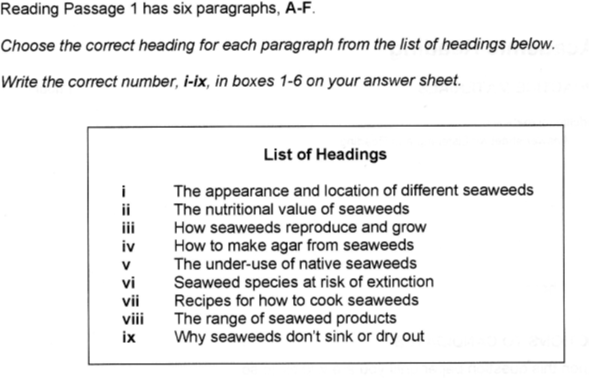
(Official Ielts Practice Materials 2, p.10: www.ielts.org)
Matching information
A set of statements placed after the reading passage but, as with headings, numbered and in random order, tests how well you can identify specific details in the passage by scanning the text and through a careful comparison of statement to content in terms of word meaning and interpretation. Once again, a distractor is added.
This type of question is most often used with Section 1 of the General Training test, as in this example.
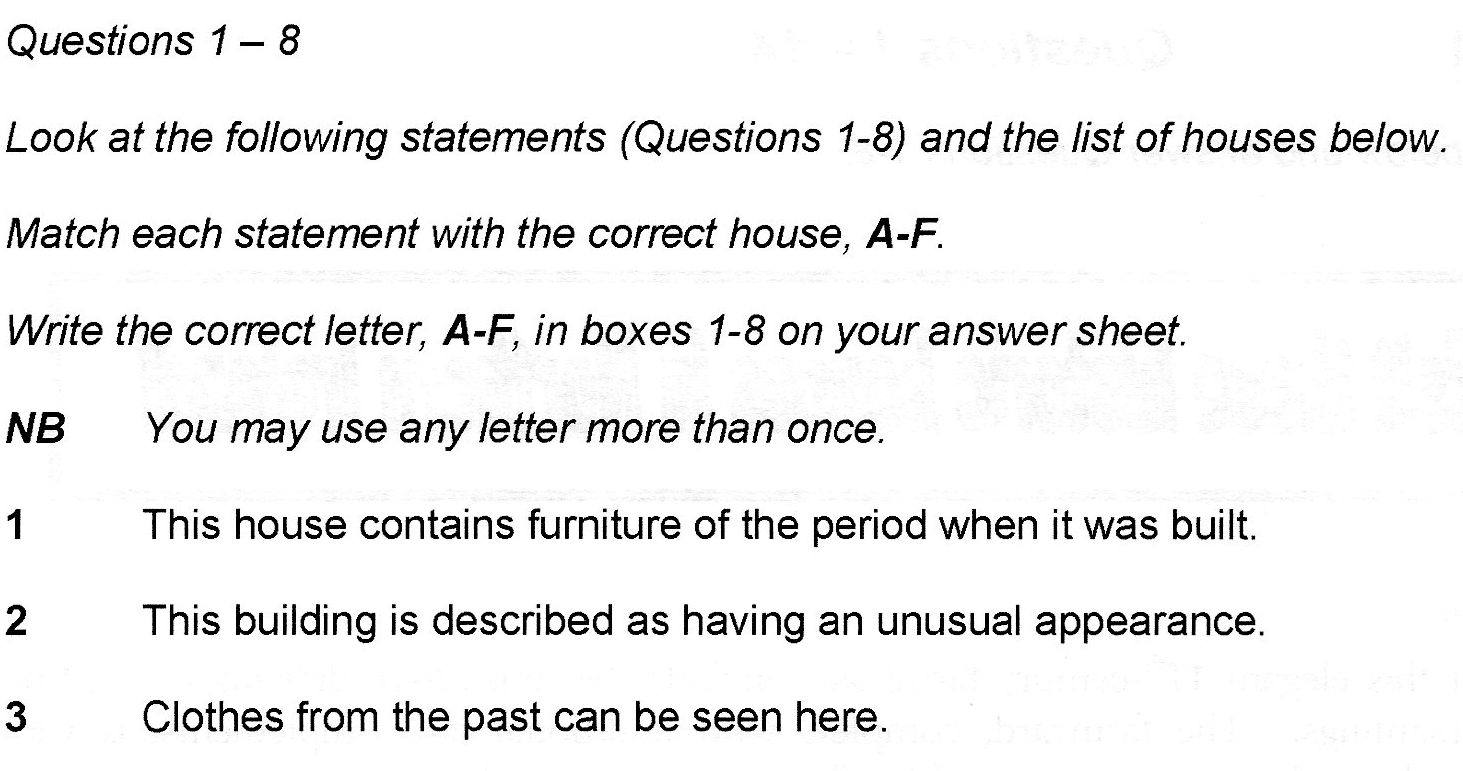
(Official Ielts Practice Materials 2, p. 38: www.ielts.org)
The text itself describes 6 buildings of historical interest. Option 1 corresponds to the description of Castle Coole which includes
The guided tour includes the rich interior decorations, furnishings and furniture of the time .....Again, notice the obvious:
furniture of the period when it was built and
furniture of the time, especially since several description mention furniture from periods distinct from that of the construction of the house in question.
Scanning the text to look at details where the key is to carefully check the first element of the "features", in this following example, three people mentioned in the reading passage with statements attributed to each.
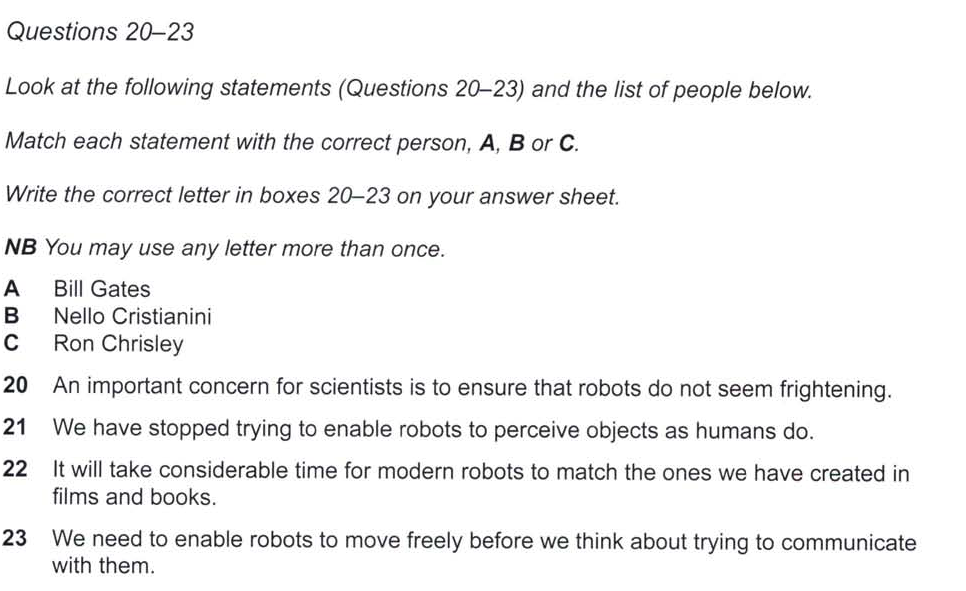
(from
The Official Cambridge Guide to IELTS, Test 2)
The answer in this case is
C, Ron Chrisley. Right at the end of the text where we read-
Chrisley said: Machines such as these take researchers into the field of socialised robotics: how to make robots act in a way that does not scare of offend people.
-
Matching sentence endings
Take a look at the example. Each ending is grammatically possible so we need to scan the reading passage to see how the question sentences paraphrase the information found there. We first identify the key words we are looking for (
managers --Texas gas company), locate the relevant part of the reading passage and then check the endings provided with the details in the text.
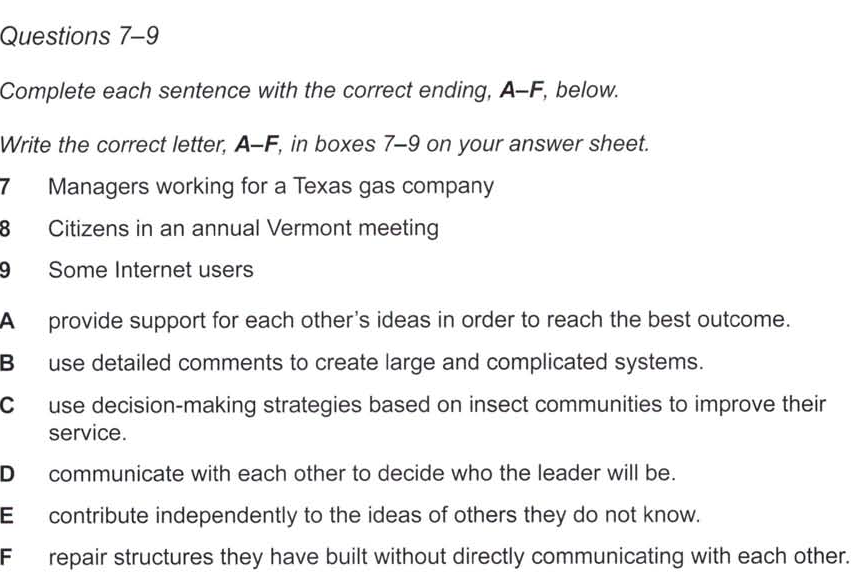
(from
The Official Cambridge Guide to IELTS Test 3)
Group 2: Completion
Completion exercises are of 5 specific kinds: completing sentences, diagrams, flow charts, notes and summaries.
No matter the type of question format, we know how important it is to read the instructions. This is especially true of this "completion" group of questions. They all require you to fill in or complete gaps with a given number of words or sometimes a number taken from the passage. What you are comparing is another version of the passage or a part of the passage in which something is missing and you need to fill in those missing parts using words or numbers from the text.
You must be particularly careful then to follow the instructions exactly (no more than three words mean just that, a maximum of three words but perhaps fewer; using one word and/or a number only means just one word or a number, no more, no less).
Now, this "other version" gives you the same information as the original passage but in a different format which may include graphics (diagram or flow chart) and makes use of synonyms and paraphrase to present that information. Once again, you are being tested on your reading comprehension and knowledge of vocabulary, from synonyms and antonyms, word families and collocation.
Let's look briefly at some examples.
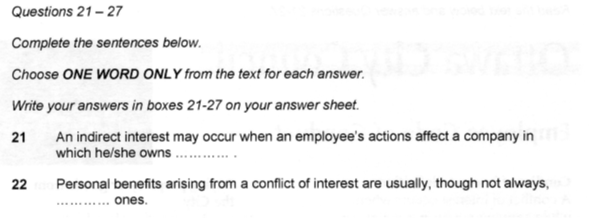
This example, from a General Training practice reading test, Section 2. Only one word to fill and if you read through each statement, checking the key words before looking back at the reading passage, you shouldn't go wrong. In this case, notice how the key at the end is "owns" ....or in the passage, "acquired", namely,
shares.
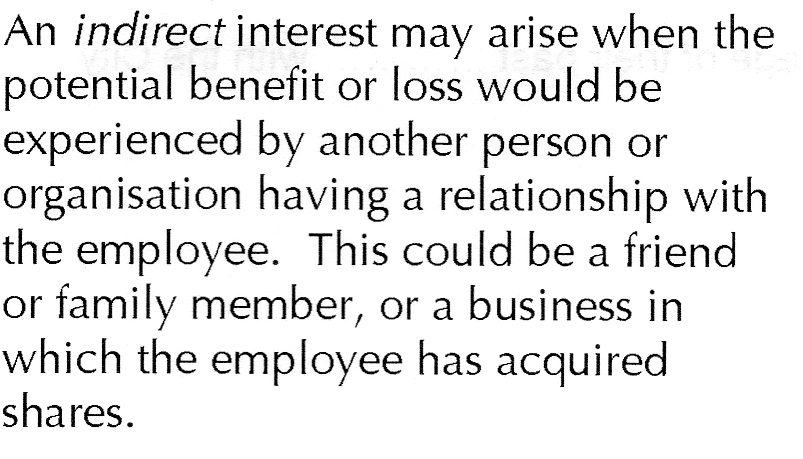
(Official Ielts Practice Materials 2: www.ielts.org)
Let's start with a diagram.
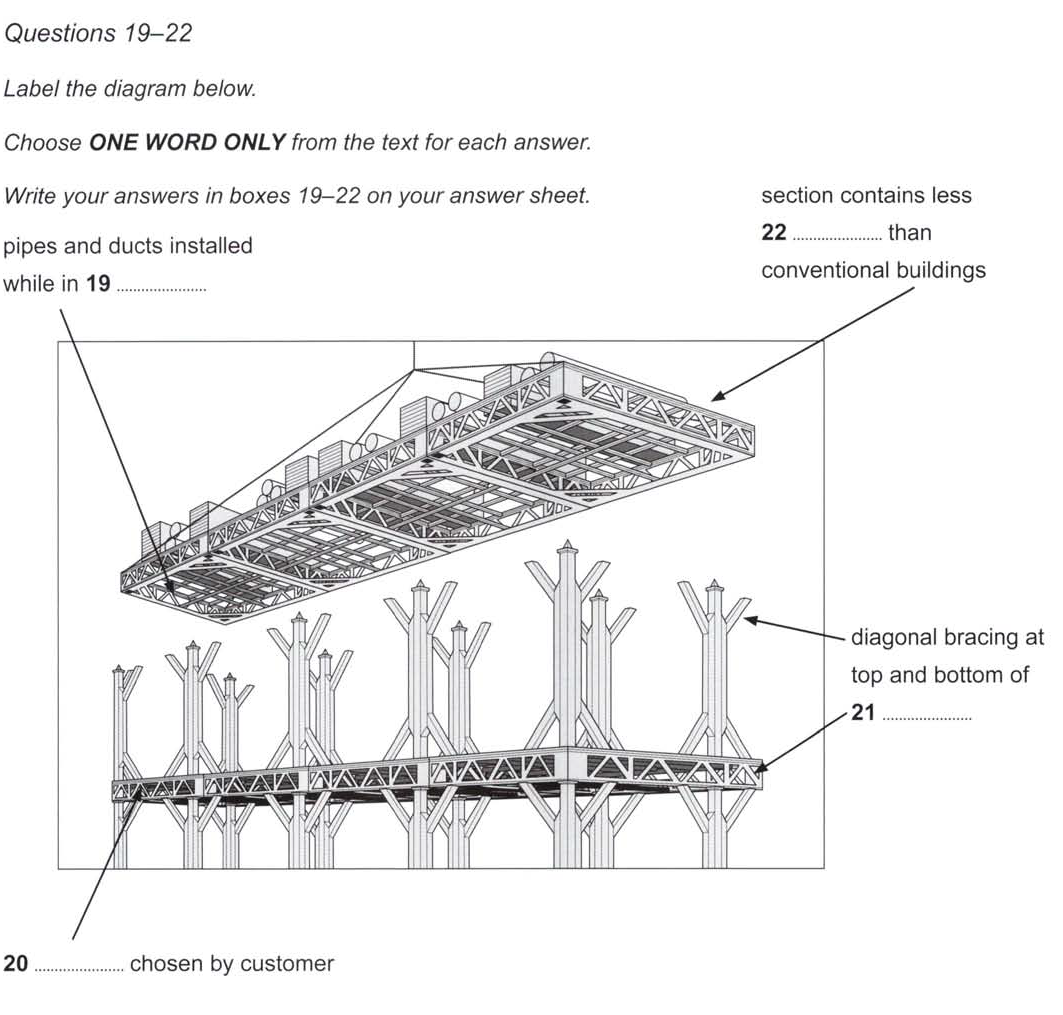
This type of question is easier than it might at first appear. Remember that there are no really specialised topics in
IELTS reading exams. You don't need to have studied architecture or engineering to follow it. In 19 for example, the very same words (
pipes and ducts) are used in the reading passage and all we need to do to is realise that
"threaded through" is equivalent to
installed in this context to see that the answer must be
factory.
(from
The Official Cambridge Guide to IELTS Test 3)
This type of question often relies on finding the relevant information by way of obvious clues such as dates, as in this example.
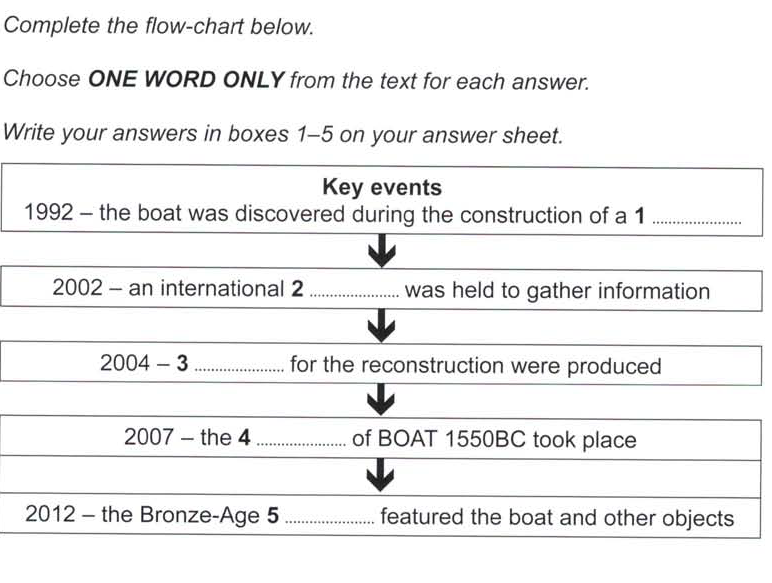
(from
The Official Cambridge Guide to IELTS Test 1)
The reading passage starts out with the sentence "It was 1992" and it goes on to tell us that
workmen were building a new road. Synonyms: build - construct.
Note completion may mean scanning several parts of the reading passage or just one part. Here, the questions are spread over 3 paragraphs but, once located, should not prove too difficult. Once again, the actual words used in the questions are in the text along with synonyms.
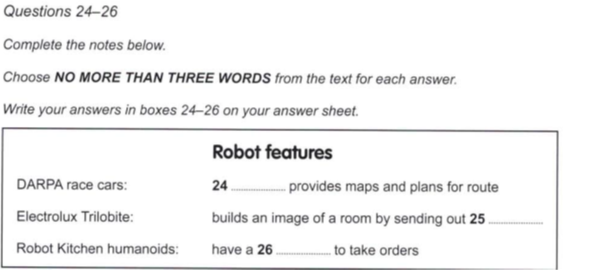
(from
The Official Cambridge Guide to IELTS Test 2)
Summary completion likewise may include information from just one paragraph or several. Use the title and the key words in it to search the text for the missing elements. Often it is a matter of seeing how a short phrase in the summary covers some of the main points made in the text itself. Here the
financial constraints mentioned in the question are found in Paragraph 1 with its references to the factors which have made revenue development more challenging. However, you also need to check the
grammar. Look out for the type of word that could fill the space. In 23 ...
due to the what? It has to be a noun group.
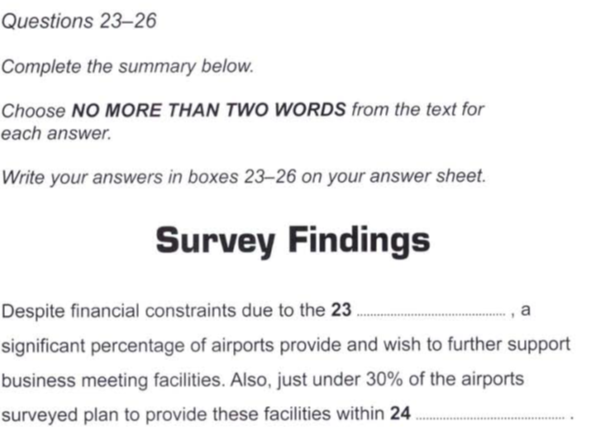
(from
The Official Cambridge Guide to IELTS Test 1)
Group 3: Multiple Choice
There are three types of multiple-choice questions. In one, you have to select from four choices (A, B, C, or D); the second type asks you to choose the best two answers from five options and the last one offers a total of seven listed options of which you select the best three. Questions are given in the order of the information in the passage.
As a test taker, you need to be skilful at scanning to find the relevant parts of the passage that correspond to the options on offer before a close reading of both the question statements and the passage. Again, both your knowledge of vocabulary, especially synonyms, is very important.
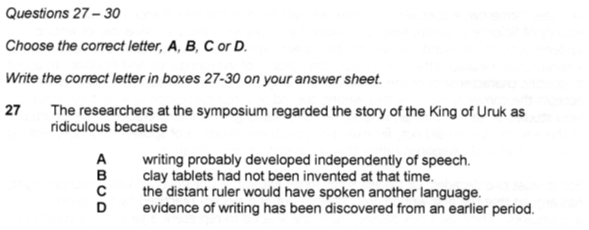
Multiple choice: a very common question type in reading tests. Selecting from 4 choices gives the examiner the chance to mix true and false details in the same lettered option. In this case, notice that the question asks precisely why the story of the King of Uruk was considered ridiculous and as the text states:
....smiled at the absurdity of a letter which the recipient would not have been able to read, the answer should be evident. Option A is also the only one where we can use information from the text to find the answer.

(Official Ielts Practice Materials 2: www.ielts.org)
Both the 2 from 5 and 3 from 7 multiple-choice question sets rely on our skill at scanning the reading passage in search of the relevant information aware that the options may include partial truths, something that is true for one and not the other, for example.
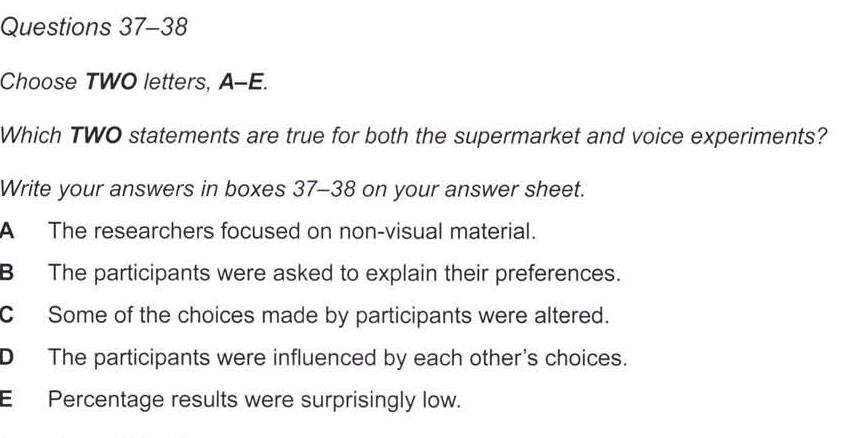
(from
The Official Cambridge Guide to IELTS Test 2, p. 187
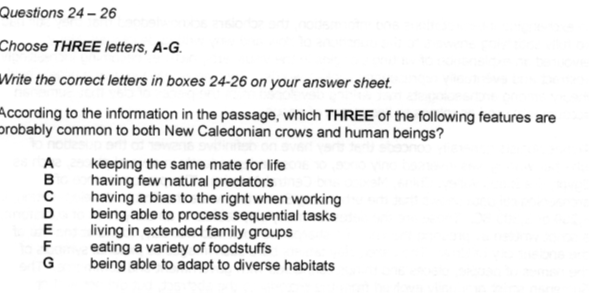
(Official Ielts Practice Materials 2: www.ielts.org)
Group 4: True or False
For many test-takers, the most demanding types of questions on the reading test involve deciding whether a statement is true or false according to the information in the text or if there is insufficient evidence to decide one way or another and therefore the choice of answer is "not given".
A variation on this is when you are asked to decide if a statement reflects or not the views or claims of the author of the text. In this case, the answers are Yes, No or Not Given in the case of lack of evidence.
In both cases, the statements are sequential.
In a sense, this is another type of matching exercise. You have to scan the passage looking for the relevant information to compare with each statement, knowing that a careful reading of both is key.
What many test-takers find difficult here is deciding if a statement is "not given". Remember, all the information we need is in the passage. If there is no clear evidence to determine if the statement is true or false, then the only answer is not given. As we have mentioned, the tricky statements are often those which contain information that is true according to the text but, taken as a whole, must be considered as false.


(both extracts from Official Ielts Practice Materials 2: www.ielts.org)
The questions might be relatively straightforward, as in the first example above taken from a practice General Training test, Section 1. All the statements are either True or False.
The second example, from the same practice test, Section 3, is more demanding. Take 36,
Most perfumes are made from natural materials. Although the reading passage mentions both natural and synthetic materials in reference to our ability to recognise smells and there follows a short description on the manufacture of a particular perfume, there is no mention at all as to whether perfumes are made from natural materials or otherwise. The answer would be "not given".
Here is an example of checking statements to see if they agree with a writer's claims.
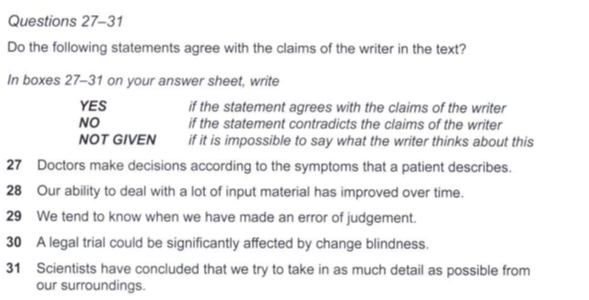
(from
The Official Cambridge Guide to IELTS Test 2)
 (Official Ielts Practice Materials 2, p.10: www.ielts.org)
(Official Ielts Practice Materials 2, p.10: www.ielts.org)
 (Official Ielts Practice Materials 2, p. 38: www.ielts.org)
The text itself describes 6 buildings of historical interest. Option 1 corresponds to the description of Castle Coole which includes The guided tour includes the rich interior decorations, furnishings and furniture of the time .....Again, notice the obvious: furniture of the period when it was built and furniture of the time, especially since several description mention furniture from periods distinct from that of the construction of the house in question.
(Official Ielts Practice Materials 2, p. 38: www.ielts.org)
The text itself describes 6 buildings of historical interest. Option 1 corresponds to the description of Castle Coole which includes The guided tour includes the rich interior decorations, furnishings and furniture of the time .....Again, notice the obvious: furniture of the period when it was built and furniture of the time, especially since several description mention furniture from periods distinct from that of the construction of the house in question.
 (from The Official Cambridge Guide to IELTS, Test 2)
The answer in this case is C, Ron Chrisley. Right at the end of the text where we read- Chrisley said: Machines such as these take researchers into the field of socialised robotics: how to make robots act in a way that does not scare of offend people.
(from The Official Cambridge Guide to IELTS, Test 2)
The answer in this case is C, Ron Chrisley. Right at the end of the text where we read- Chrisley said: Machines such as these take researchers into the field of socialised robotics: how to make robots act in a way that does not scare of offend people.
 (from The Official Cambridge Guide to IELTS Test 3)
(from The Official Cambridge Guide to IELTS Test 3)
 This example, from a General Training practice reading test, Section 2. Only one word to fill and if you read through each statement, checking the key words before looking back at the reading passage, you shouldn't go wrong. In this case, notice how the key at the end is "owns" ....or in the passage, "acquired", namely, shares.
This example, from a General Training practice reading test, Section 2. Only one word to fill and if you read through each statement, checking the key words before looking back at the reading passage, you shouldn't go wrong. In this case, notice how the key at the end is "owns" ....or in the passage, "acquired", namely, shares.
 (Official Ielts Practice Materials 2: www.ielts.org)
(Official Ielts Practice Materials 2: www.ielts.org)
 This type of question is easier than it might at first appear. Remember that there are no really specialised topics in IELTS reading exams. You don't need to have studied architecture or engineering to follow it. In 19 for example, the very same words (pipes and ducts) are used in the reading passage and all we need to do to is realise that "threaded through" is equivalent to installed in this context to see that the answer must be factory.
(from The Official Cambridge Guide to IELTS Test 3)
This type of question is easier than it might at first appear. Remember that there are no really specialised topics in IELTS reading exams. You don't need to have studied architecture or engineering to follow it. In 19 for example, the very same words (pipes and ducts) are used in the reading passage and all we need to do to is realise that "threaded through" is equivalent to installed in this context to see that the answer must be factory.
(from The Official Cambridge Guide to IELTS Test 3)
 (from The Official Cambridge Guide to IELTS Test 1)
The reading passage starts out with the sentence "It was 1992" and it goes on to tell us that workmen were building a new road. Synonyms: build - construct.
(from The Official Cambridge Guide to IELTS Test 1)
The reading passage starts out with the sentence "It was 1992" and it goes on to tell us that workmen were building a new road. Synonyms: build - construct.
 (from The Official Cambridge Guide to IELTS Test 2)
(from The Official Cambridge Guide to IELTS Test 2)
 (from The Official Cambridge Guide to IELTS Test 1)
(from The Official Cambridge Guide to IELTS Test 1)
 Multiple choice: a very common question type in reading tests. Selecting from 4 choices gives the examiner the chance to mix true and false details in the same lettered option. In this case, notice that the question asks precisely why the story of the King of Uruk was considered ridiculous and as the text states: ....smiled at the absurdity of a letter which the recipient would not have been able to read, the answer should be evident. Option A is also the only one where we can use information from the text to find the answer.
Multiple choice: a very common question type in reading tests. Selecting from 4 choices gives the examiner the chance to mix true and false details in the same lettered option. In this case, notice that the question asks precisely why the story of the King of Uruk was considered ridiculous and as the text states: ....smiled at the absurdity of a letter which the recipient would not have been able to read, the answer should be evident. Option A is also the only one where we can use information from the text to find the answer.
 (Official Ielts Practice Materials 2: www.ielts.org)
(Official Ielts Practice Materials 2: www.ielts.org)
 (from The Official Cambridge Guide to IELTS Test 2, p. 187
(from The Official Cambridge Guide to IELTS Test 2, p. 187
 (Official Ielts Practice Materials 2: www.ielts.org)
(Official Ielts Practice Materials 2: www.ielts.org)

 (both extracts from Official Ielts Practice Materials 2: www.ielts.org)
The questions might be relatively straightforward, as in the first example above taken from a practice General Training test, Section 1. All the statements are either True or False.
The second example, from the same practice test, Section 3, is more demanding. Take 36, Most perfumes are made from natural materials. Although the reading passage mentions both natural and synthetic materials in reference to our ability to recognise smells and there follows a short description on the manufacture of a particular perfume, there is no mention at all as to whether perfumes are made from natural materials or otherwise. The answer would be "not given".
(both extracts from Official Ielts Practice Materials 2: www.ielts.org)
The questions might be relatively straightforward, as in the first example above taken from a practice General Training test, Section 1. All the statements are either True or False.
The second example, from the same practice test, Section 3, is more demanding. Take 36, Most perfumes are made from natural materials. Although the reading passage mentions both natural and synthetic materials in reference to our ability to recognise smells and there follows a short description on the manufacture of a particular perfume, there is no mention at all as to whether perfumes are made from natural materials or otherwise. The answer would be "not given".

